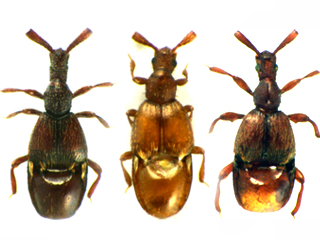Three New Articerodes Discovered
Posted by: Loren Coleman on April 20th, 2008

New insects are literally found daily, by the hundreds every year. Cryptozoology, as I have noted, generally deals with the discovery of larger animals, mostly vertebrates, with the now-and-then large invertebrate, such as the giant squid (verified) and giant octopus (still an active cryptid).
But, it appears the entomologists deserve their due sometimes. They need recognition as much as the next discoverers for find new species, and can generate publicity, especially if the new species are beautiful, unique, or strange to observe. It’s always been that way.
To wit, some news out of the rainforests of Thailand calls our attention to the insects:
A group of Thai entomologists announced the discovery of three previously unidentified new species of snout beetles in Thailand’s tropical forests—an indication of the biodiversity still to be discovered in Thai woodlands.
New to the world’s record of beetle species, the three newly discovered were named Articerodes thailandicus, Articerodes ohmumoi and Articerodes jariyae.
The first was named in honor of Thailand, the second recognising a distinguished entomologist from Japan and the third to grant historical honor to Khao Khitchakut, Chanthaburi province—the only habitat to shelter these species of snout beetle.
An entomologist at the Department of National Parks, Wildlife and Plant Conservation, Wattana Sukchoowong, revealed that the three species were confirmed by Japanese specialists to be the three newest of the 105 specimens recently identified.
Mr. Wattana said the three new species were a good indication of the areas’ biodiversity.
Red brown with the size of merely 1.2 millimetres with 4 cylindrical antenna, the three newly discovered bugs can be found at Khao Ang Rue Nai wildlife sanctuary in the eastern Chachoengsao province, Khao Soi Dao wildlife sanctuary and Khao Khitchakut national park in eastern Chanthaburi province.
The Thai entomologist revealed, though not being threatened as just yet, the new species might face extinction if the locale’s ecosystem were made unbalanced, especially by climate change.
About Loren Coleman
Loren Coleman is one of the world’s leading cryptozoologists, some say “the” leading living cryptozoologist. Certainly, he is acknowledged as the current living American researcher and writer who has most popularized cryptozoology in the late 20th and early 21st centuries.
Starting his fieldwork and investigations in 1960, after traveling and trekking extensively in pursuit of cryptozoological mysteries, Coleman began writing to share his experiences in 1969. An honorary member of Ivan T. Sanderson’s Society for the Investigation of the Unexplained in the 1970s, Coleman has been bestowed with similar honorary memberships of the North Idaho College Cryptozoology Club in 1983, and in subsequent years, that of the British Columbia Scientific Cryptozoology Club, CryptoSafari International, and other international organizations. He was also a Life Member and Benefactor of the International Society of Cryptozoology (now-defunct).
Loren Coleman’s daily blog, as a member of the Cryptomundo Team, served as an ongoing avenue of communication for the ever-growing body of cryptozoo news from 2005 through 2013. He returned as an infrequent contributor beginning Halloween week of 2015.
Coleman is the founder in 2003, and current director of the International Cryptozoology Museum in Portland, Maine.










your mention of climate change vs. biodiversity/extinction is a good point that is too rarely raised in the global warming debate.
folks always mention the known species that are being annihilated, but all too often, fail to include the cryptids yet to be discovered/uncovered which are — in all likelihood — even more vulnerable given they’re probably semi-extinct to begin with given the rarity of sightings, evidence, etc.
Beautiful